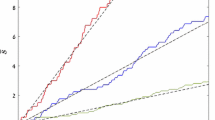Abstract
In order to model any macroscopic system, it is necessary to aggregate both spatially and taxonomically. If average processes are assumed, then kinetic equations of “population dynamics” can be derived. Much effort has gone into showing the important effects introduced by non-average effects (fluctuations) in generating symmetry-breaking transitions and creating structure and form. However, the effects of microscopic diversity have been largely neglected. We show that evolution will select for populations which retain “variability,” even though this is, at any given time, loss-making, predicting that we shall not observe populations with “optimal behavior,” but populations which can “learn.” This lesser short-term efficiency may be why natural diversity is so great. Evolution is seen to be “driven” by the noise to which it leads.
Similar content being viewed by others
References
G. Nicolis and I. Prigogine,Self-Organization in Non-Equilibrium Systems (Wiley-Interscience, New York, 1977).
I. Prigogine and P. M. Allen, “The challenge of complexity,” inSelf-Organization and Dissipative Structures (University of Texas Press, Austin, Texas, 1982).
H. Haken,Synergetics: An Introduction (Springer Series on Synergetics, Vol. 1) (Springer, New York, 1977).
C. Darwin,The Origin of Species (John Murray, London, 1859).
R. A. Fisher,The Genetical Theory of Natural Selection (Dover, New York, 1958).
S. Wright,Evolution and the Genetics of Populations, Volumes I, II, III, and IV (University of Chicago Press, 1968, 1969, 1977, 1973).
E. B. Ford,Ecological Genetics (Methuen, London, 1964).
E. Mayr,The Growth of Biological Thought: Diversity, Evolution and Inheritance (Harvard University Press, Cambridge, 1982).
R. Dawkins,The Selfish Gene (Oxford University Press, Oxford, 1980).
N. Eldredge and S. J. Gould, inModels in Palaeobiology, T. Schopf, ed. (Freeman, San Francisco, 1972).
J. Maynard Smith,Evolution and the Theory of Games (Cambridge University Press, Cambridge, 1982).
R. M. May,Stability and Complexity in Model Ecosystems (Princeton University Press, Princeton, 1973).
V. C. Wynne-Edwards,Animal Dispersion in Relation to Social Behaviour (Oliver and Boyd, Edinburgh, 1962).
V. C. Wynne-Edwards,Evolution through Group Selection (Blackwell Scientific Publications, Oxford, 1986).
D. S. Wilson,The Natural Selection of Populations and Communities (Benjamin/Cummings, Menlo Park, California, 1980).
L. E. Orgel and F. Crick,Nature (London) 286, 604–607 (1980).
W. F. Doolittle and C. Sapienza,Nature (London) 284, 601–603 (1980).
G. Dover,Nature (London) 299, 111–117 (1982).
L. Van Valen,Evolutionary Theory,1, 1–30 (1973).
J. Roughgarden,The Theory of Population Genetics and Evolutionary Ecology: An Introduction (Macmillan, New York, 1979).
G. H. Waddington,Mathematical Challenges to the Neo-Darwinian Interpretation of Evolution, P. S. Moorehead and M. M. Kaplan, eds. (Wistar Institute Press, Philadelphia, 1967), pp. 113–115.
E. Jantsch,The Self-Organizing Universe (Pergamon Press, New York, 1980).
M. Conrad,Adaptability: The Significance of Variability from Molecule to Ecosystem (Plenum Press, New York, 1983).
M. Eigen and P. Schuster,The Hypercycle (Springer, Berlin, 1979).
R. Dawkins,The Blind Watchmaker (Longman, Harlow, England, 1986).
W. M. Post and S. L. Pimm, “Community assembly and food web stability,”Math. Biosc. 64, 169–192 (1983).
W. Ebeling and A. Engel,Syst. Anal. Model Simul. 3 (5), 377–385 (1986).
P. M. Allen and J. McGlade,Can. J. Fish. Aquat. Sci. 43, 1187–1200 (1986).
Author information
Authors and Affiliations
Rights and permissions
About this article
Cite this article
Allen, P.M., McGlade, J.M. Evolutionary drive: The effect of microscopic diversity, error making, and noise. Found Phys 17, 723–738 (1987). https://doi.org/10.1007/BF01889545
Received:
Issue Date:
DOI: https://doi.org/10.1007/BF01889545




